By Pat Elder, World BEYOND War, September 18, 2019

Fire fighters at March Air Reserve Base in Riverside County practice dousing a petroleum fire using carcinogenic foam.
There was an earthquake in California on August 23, 2019, although the ground didn’t move, and few noticed. That was the day California ordered the state’s water systems to establish the nation’s lowest Notification Levels for dangerous Per and Poly Fluoroalkyl Substances (PFAS) in drinking water.
Two of the deadliest PFAS are Perfluorooctane Sulfonate (PFOS) and Perfluorooctanoic Acid (PFOA). The Notification Level for PFOA has been lowered from 14 parts per trillion (ppt) to 5.1 ppt and the Notification Level for PFOS has been lowered from 13 ppt to 6.5 ppt. These are the lowest levels at which they can be reliably detected in drinking water using current technologies.
Effective January 1, 2020, water systems must notify local government if the limits are exceeded. The State Water Board recommends that water agencies also notify customers and the California Division of Drinking Water (DDW).
The policy reflects the state’s recognition that the smallest amounts of these substances endanger human health. State water officials say the new levels are “intended to protect against cancer and noncancer effects, including effects on the liver and immune system.”
If a chemical is present in drinking water that is provided to consumers at concentrations “considerably greater” than the notification level, DDW recommends that the drinking water system take the source out of service. The DDW will recommend a water system to be shut down if PFOA and PFOS total more than 70 ppt. This is known as the “response level.”
70 ppt is the federal EPA’s non-regulatory, non-binding “advisory” for both contaminants. The lack of federal involvement has caused several states to step in to regulate water contamination – a role traditionally played by the federal government. The people of California can no longer rely on the federal government to safeguard drinking water.
“Our research shows that the EPA’s unenforceable recommendation of 70 ppt is about 100-fold too high to protect us from adverse health impacts,” argues Dr. Philippe Grandjean, a Harvard University public health professor. “PFAS are not essential chemicals, and we can make do without using them. We must protect communities from the dangers of PFAS exposure by phasing out the use of PFAS chemicals and by establishing a strong drinking water standard that is based on science,” he said.
Earlier this year, the California State Water Resources Control Board issued orders to owners and operators of more than a thousand facilities in California requiring testing for PFAS. The results are beginning to trickle in, and it is apparent numerous wells across the state are contaminated. Seven agencies have shut down wells in the past year because of the presence of PFAS and two more plan closures, according to the Orange County Register. None of the facilities to be tested by the state are military installations, known to be major users of PFAS chemicals.
A “waterquake” will hit California if large numbers of suppliers are forced to turn off the tap and hundreds of thousands of customers receive letters saying their water is contaminated. Imagine receiving a letter that says we think this stuff causes cancer and there’s plenty of it in your water – but your results aren’t higher than 70 ppt so you can continue to drink it.
The state is also asking water agencies to test for 12 other PFAS chemicals, although more than 5,000 potentially dangerous PFAS varieties have been developed. Even so, California is ahead of the curve, considering that most states have still not acted to protect the public.
The Role of the Military

Although a handful of news accounts have recently reported on the results of PFAS testing in California, there has been little public analysis on the origin of the contamination or ways to stop it. The results of the Riverside County wells tested for PFAS toxins suggest the military may be a cause of much of the contamination.
==========================================================
Results of Riverside County wells tested for PFAS toxins
Table 3.1-1 Summary of Groundwater Analytical Testing Results Site Inspection of Aqueous Film Forming Foam (AFFF) Release Areas Site Inspection Report Addendum 01 March Air Reserve Base, California.
=========================================================

Contaminated Water
89 wells were tested in Riverside County – a huge jurisdiction about the size of New Jersey. 13 wells exceeded the notification levels and they’re located in the vicinity of March Air Reserve Base.
Eastern Municipal Water District (Eastern) is two miles from March. The city of Riverside is just a few miles to the north and the Elsinore Valley Municipal Water District is about 15 miles down the Perris Valley Storm Drain from the Air Force base.
Carcinogenic aqueous film-forming foam has been liberally and routinely used in fire-training exercises on base since 1970 and have contaminated drinking wells, the groundwater, sewer systems, landfills, and the Perris Valley Storm Drain.
So, it’s no surprise that Eastern, which provides water to over half a million people in Riverside County, detected high levels of PFAS in a groundwater well used for drinking water in 2016. Two of their supply wells are located just a few thousand feet south of a fire training area on base. Eastern immediately took one well offline and identified the source of the contamination as March Air Reserve Base.
Eastern released this statement in July of 2017, “Well 59 is located southeast of March Air Reserve Base and it is suspected that PFC entered the groundwater from the use of AFFF at a historic firefighting training area on the east side of March Air Reserve Base.”
A 2018 DOD report, Addressing Perfluorooctane Sulfonate (PFOS) and Perfluoroctanoic Acid (PFOS), included data on the base’s contamination of the Eastern Municipal Water District’s well.
According to the report, March ARB had one public drinking water system and two private wells that tested above the EPA’s Lifetime Health Advisory (LHA) of 70 ppt. The levels for PFOS/PFOA in the public water drinking system (Eastern’s Well 59, located at Indian Avenue and Nance St. in Perris) reached 168 ppt, about 30 times the new California limit.
March ARB released this statement:
“Supplied two residences with bottled water while working connection to municipal water service. Public Drinking Water well shut off and Air Force reimbursing for the incremental cost increase of purchasing replacement water. Complete Cooperative Agreement with DW purveyor to fund treatment for impacted municipal DW well.”
It’s Air Force-speak admitting that they may have poisoned people’s drinking water for two generations.
The Trump Administration attempted to block the release of last year’s Pentagon report, warning the findings would cause a ‘public relations nightmare,’ but the lack of national mainstream attention has proven otherwise. California’s actions are likely to change that.
An engineer’s report on the contamination
contained redactions by the Air Force
==========================================================

– FINAL SITE INSPECTION REPORT FOR AQUEOUS FILM FORMING FOAM AREAS FORMER MARCH AIR FORCE BASE – Prepared by: Aerostar SES LLC 1006 Floyd Culler Court Oak Ridge, Tennessee 37830 Contract No. FA8903-08-D-8785 – July 2018
===========================================================
Further redactions by the Air Force appear on this site inspection report of aqueous film-forming foam release areas.
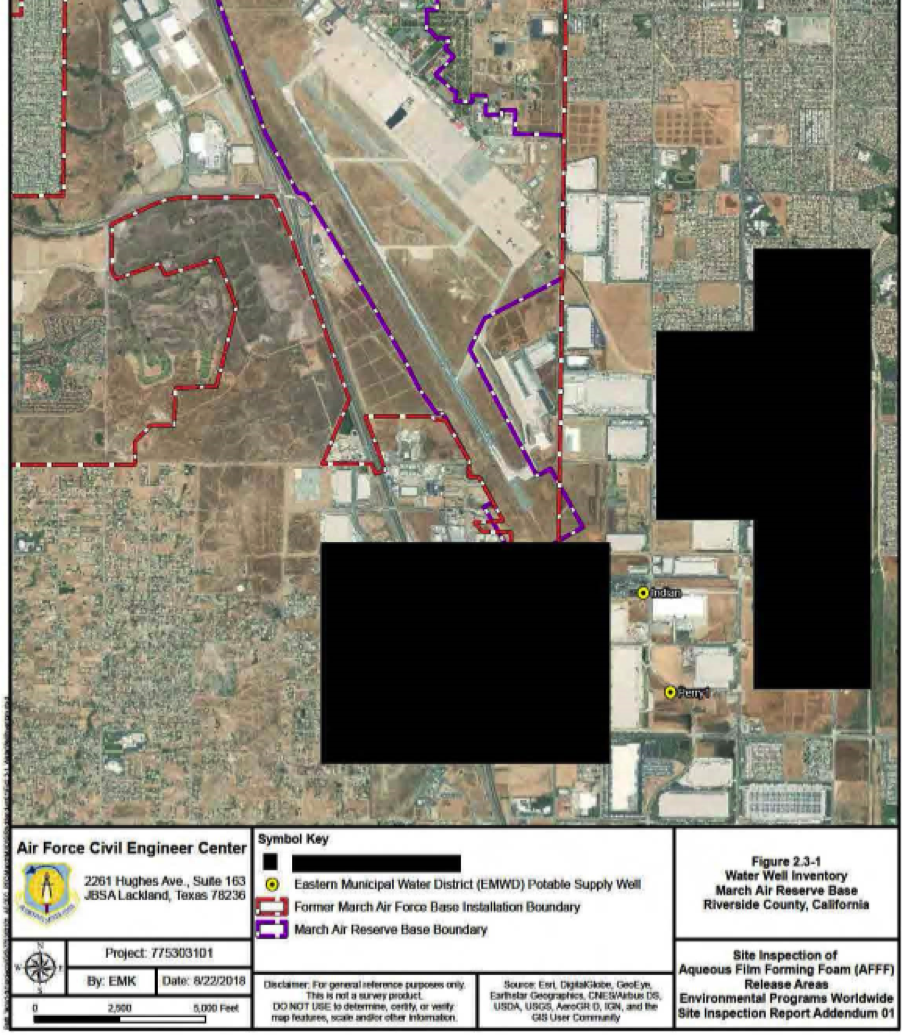
PFAS were detected in Eastern’s Well 56, although the water was under the 70 ppt threshold. According to Eastern, “The PFC (PFAS) concentrations in Well 56 were significantly below the new Public Health Advisories, barely detectable, and therefore Well 56 remains operational.”
Well 56 was shown to have 17 ppt of PFOS/PFOA in its water, much higher than the new levels set to take effect in January. People are currently being served water that will be considered tainted in a few months.
According to Eastern, the Air Force has assumed full responsibility for the presence of PFAS in Well 59 and the two private wells. The Air Force will pay $5.9 million for the cost of imported water until Well 59 is equipped to treat the contamination.
Communities across the country are demanding the same response while the Air Force is largely non-compliant. It’s not surprising. The Air Force has been claiming in court that “federal sovereign immunity” allows it to disregard any state’s regulations regarding PFAS contamination.
To make matters worse, the heavily contaminated groundwater levels under the base have been gradually rising as the demand for groundwater pumping to irrigate crops has fallen due to increasing urbanization. In some places on base the groundwater has risen to within three feet of the surface.
Contaminated Sewer Systems
In 2018, PFOS/PFOA was found in concentrations of 747 ng/l (747 ppt) in the groundwater under the West March Wastewater Treatment Plant and Sludge Drying Beds. PFOS was found in concentrations of 6.32 J µg/kg in the sludge.
The sludge is transported to landfills on base and disposed of off-site at undisclosed locations where the carcinogens leach into the groundwater. The EPA has still not set PFAS limits on sewer sludge, which is often applied to farm fields, contaminating crops, providing a potent pathway to human ingestion.
These are forever chemicals. They don’t break down in nature.
Currently, Western Municipal Water District treats three million gallons of water per day. Treated sewer water is discharged to the March wastewater treatment plant (WWTP), to the Heacock Channel, and reinjected into the aquifer.
On-base groundwater monitoring wells showed PFOS/PFOA levels up to 9,666 ppt. while off-base groundwater monitoring wells reported levels of 3,195 ppt. March Air Reserve Base has poisoned the local drinking water and continues to contaminate the region with these “forever chemicals.” Meanwhile, the Air Force continues to use the carcinogenic foam.
Contaminated Surface Water
For 35 years March ARB has used cancer-causing foams during routine fire-fighting exercises, allowing the carcinogens to contaminate the environment.
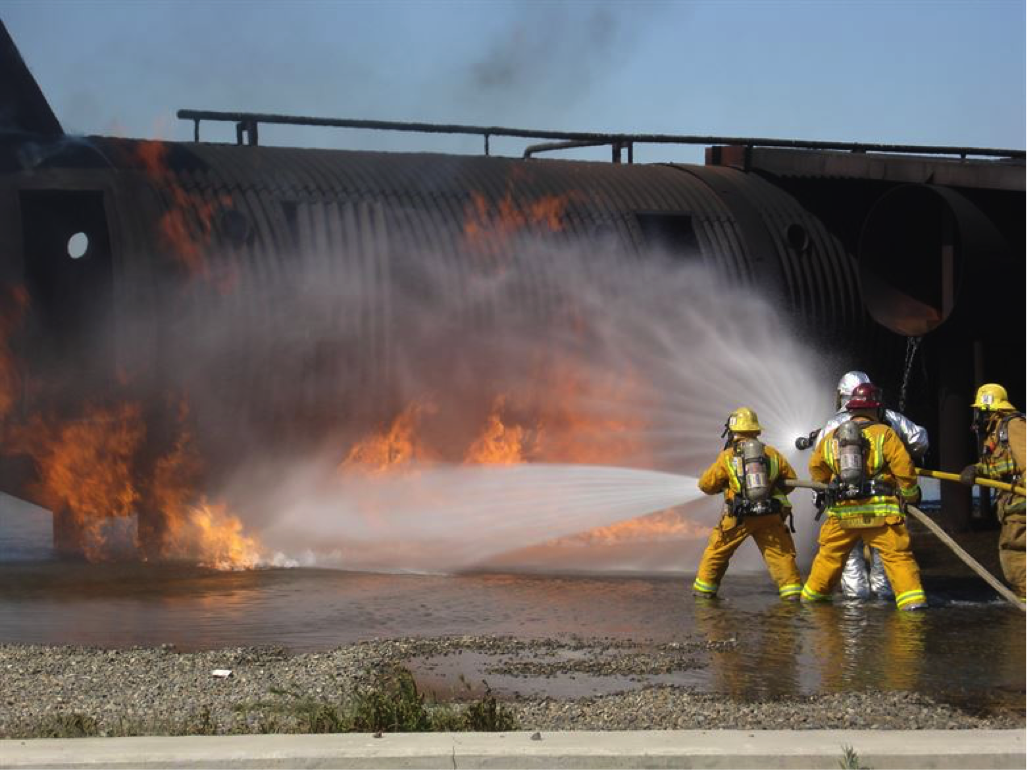
Airmen at March Reserve Air Force Base apply carcinogenic foam during a routine fire-training exercise. – U.S. Air Force photo
Follow the surface water
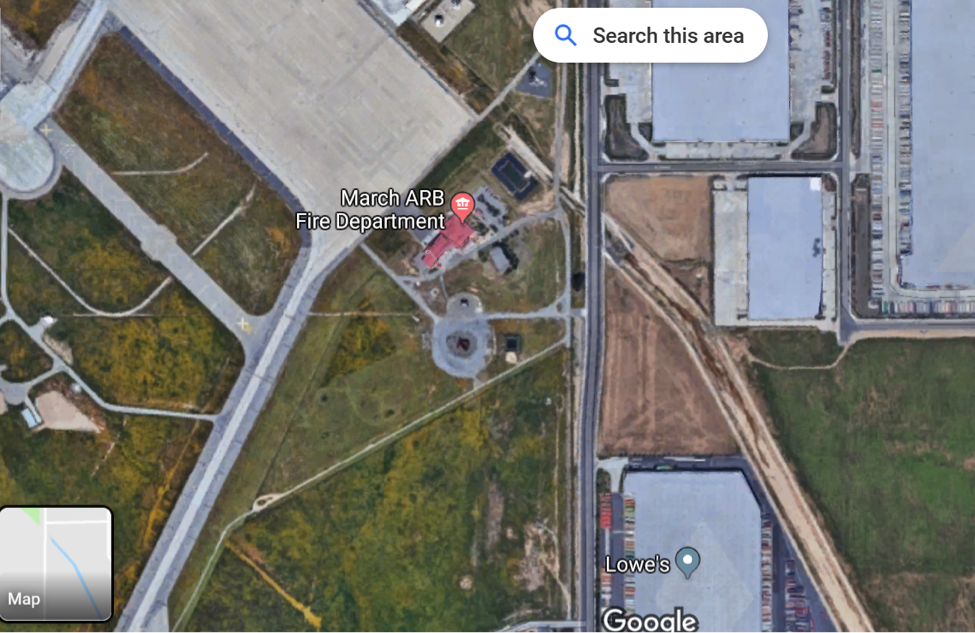
A prescription for disaster at March ARB: Fire training areas saturated with PFAS chemicals used in firefighting foam are located at the end of the runway and just above the drainage ditch to the Perris Valley Storm Drain, shown here.
Follow the Surface Water
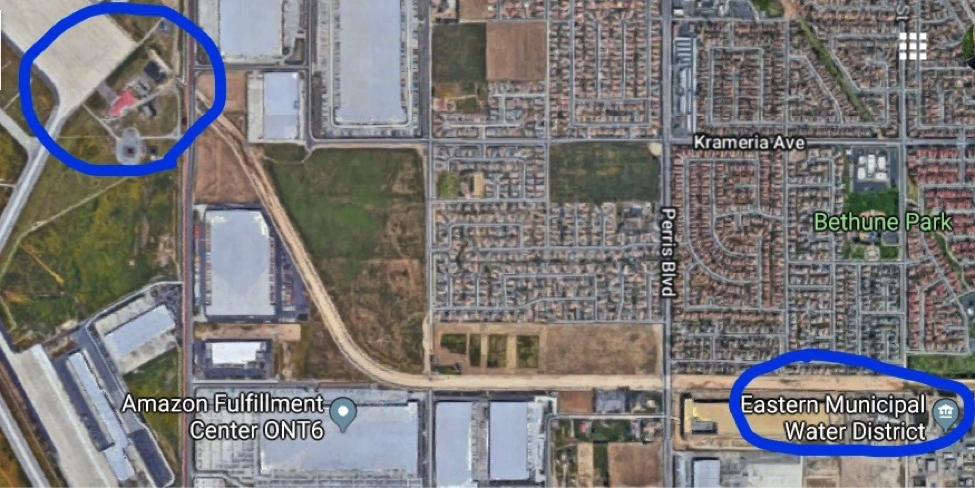
The Eastern Municipal Water District is located on the Perris Valley Storm Drain, close to the runway and the fire training area at March Air Reserve Base. The ground surface at March ARB slopes gently southeastward.
In June, 2019 the Air Force diverted $66 million from other projects to start cleaning up PFAS. The command announced that part of those funds is being used to begin addressing seriously contaminated groundwater and drinking water in communities around three bases: Wurtsmith AFB in Michigan, Pease AFB in New Hampshire, and March, although bases across the country are many times more contaminated than March. England Air Force Base outside of Alexandria, Louisiana had PFAS in its groundwater a thousand times greater than March and it’s not getting any special help.
Follow the Surface Water
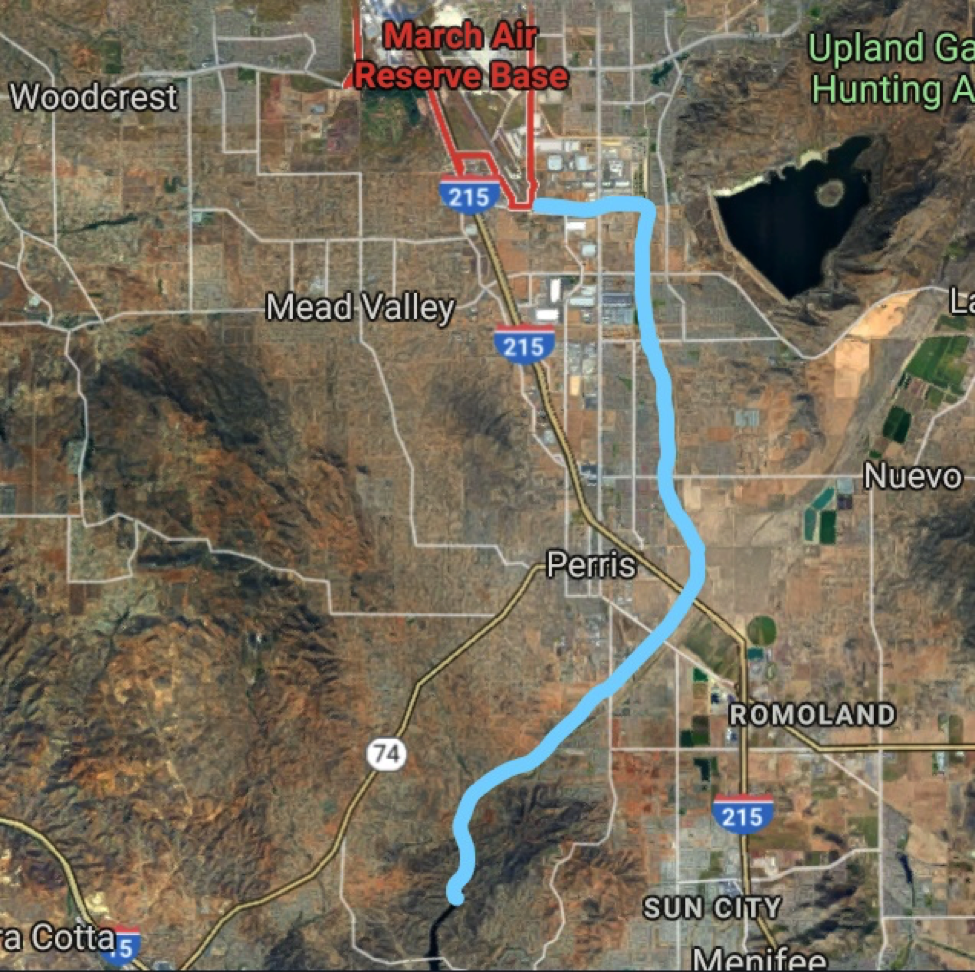
California issues a Permit to the U.S. Air Force March Air Reserve Base for waste discharge from the base to the Perris Valley Storm Drain. The storm drain, shown here, flows from March ARB to Canyon Lake, just a few miles from the Elsinore Valley Municipal Water District.
An Air Force Report prepared by Amec Foster Wheeler Programs, Inc: Site Inspection of Aqueous Film Forming Foam (AFFF) Release Areas – March Air Reserve Base, November, 2018, documents the use of AFFF over the years.
AFFF containing PFAS has been used for nearly 50 years in firefighting training activities, testing of firefighting equipment, extinguishing petroleum fires, and in fire suppression systems at several Installation buildings. Twenty-three potential AFFF release areas were identified, including the former Fire Station (Former Building 1223) and the Current Fire Station (Building 1290).
The Air Force says the volume of AFFF used at the site “has not be quantified” although the military has known PFAS is poisonous since at least 1974 and Dupont scientists who helped formulate the substances, have been aware of severe adverse health impacts since the mid-sixties.
In addition to the PFAS, March has been dumping the following extraordinarily deadly substances into the ground:
- trichloroethene,
- bis(2-ethylhexyl) phthalate
- benzene
- carbon tetrachloride
- 1,1-dichlororethene
- 1,2,- dichloroethane
- cis-1,2- dichloroethene
- methylene chloride
- tetrachloroethene
The Amec Foster Wheeler report documents a history of crashes on March ARB that involved massive releases of the carcinogenic foams. They report that high levels of PFAS have been detected in groundwater downgradient from the March ARB.
Lake Perris, located about 4 miles to the southeast of March ARB, is contaminated with dangerously high levels of Mercury and Polychlorinated Biphenyls (PCBs), two extraordinarily poisonous substances affiliated with military operations. In July, 2019 the California Office of Environmental Health Hazard Assessment (OEHHA) issued an advisory for eating fish from Lake Perris, because of the poisoned water. PFAS levels in the lake are not publicly available.
Although there are many suitable non-carcinogenic foams for fighting fires, the military says PFAS is “mission critical.” Throughout Europe, most air bases and civilian airports have switched to fluorine-free fire-fighting foams while they begin cleaning up the environmental catastrophe caused by using PFAS for two generations. US military installations in Europe and around the world still use the carcinogenic foams, however.

